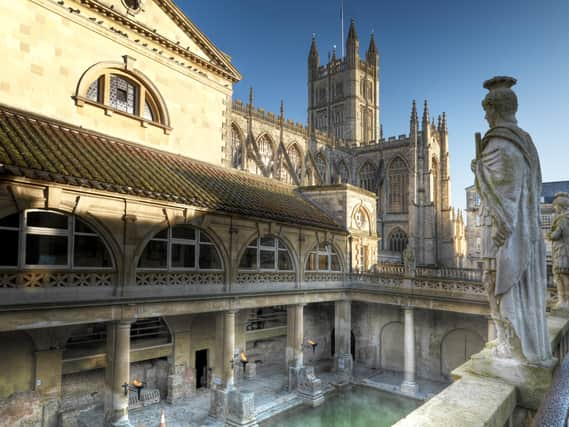Discovering the delights of Bath


Famous for its Royal Crescent of 18th Century houses, the Somerset city has much more besides, whether it be culture, history, art, shops or food.
Jane Austen was probably the Georgian city’s most famous inhabitant but Bath’s history goes back as far 60AD when it was a Roman spa town, Aquae Sulis.
Advertisement
Hide AdAdvertisement
Hide AdThe Roman Baths site is still one of the town’s most popular visitor attractions and visitors to the city can also take a dip at the Thermae Bath Spa in an impressive new building.
Bath Abbey, in the heart of the city and within the main shopping area is a beautiful religious building which is on the spot of former places of worship dating back to Saxon times.
The present building, an example of Perpendicular architecture, dates back to 1499.
Nearby is the famous Pulteney Bridge, one of only a handful of examples in the world of a bridge combined with a shopping street. Another example is the Ponte Vecchio in Florence.
Advertisement
Hide AdAdvertisement
Hide AdThe bridge is probably the spot in Bath which is photographed the most, particularly since it was used as the location for Javert’s suicide in Les Misérables movie.
Pulteney Bridge was designed in 1769 by Robert Adam and is named after Frances Pulteney who was the wife of landowner William Johnstone Pulteney.
The classical-style architecture features pediments, pilasters and leaded domes and the structure was opened in 1770 to enduring acclaim.
There are two streets in particular which stand out in Bath. One is the famous Royal Crescent built in the second half of the 18th century by John Wood the Younger.
Advertisement
Hide AdAdvertisement
Hide AdYou probably wouldn’t be able to afford to live there (they’re worth way over a million pounds each apparently) but you can get an idea of what they might look like inside by popping into the museum at No 1 Royal Crescent.
The other well-known residential street is The Circus, originally King’s Circus, a perfectly circular residential location just down the road from Royal Crescent. This was built by John Wood the Elder supposedly with a diameter to match Stonehenge in which he was interested.
Another little secret is that The Circus and adjacent Gay Street form part of a key shape of streets which has symbolic links to Freemasonry. Mr Wood the Elder was, as you may have guessed, a Mason.
There are museums galore across Bath, ranging from one dedicated (inevitably) to Jane Austen alongside others focusing on themes such as fashion, glass, America, architecture, and the Masons.
Advertisement
Hide AdAdvertisement
Hide AdThe Jane Austen Centre, at 40 Gay Street, is pretty easy to spot given the chap outside in clothes of years long past.
The noted wordsmith (or is it wordsmithess?) paid two visits to the city of Bath back in the eighteenth century and resided there from 1801 to 1806.
Bath had a big influence on her novels Northanger Abbey and Persuasion, as well as other literary efforts.
The aforementioned museum at No 1 Royal Crescent will also take you back in time.
Advertisement
Hide AdAdvertisement
Hide AdIt has been decorated and furnished to make it resemble the other properties on the famous street during the period 1776 to 1796 utilising old furniture, pictures and objects.
The fascinating musuem, which is a charity, shows what life was like both above and below stairs back in the eighteenth century.
There is so much to see but the big advantage of Bath is that it is rather compact, with most of the attractions in a relatively small area around the centre.
It has shops galore, with a plethora of designer names, and there are a wealth of opportunities to eat and drink should all that sightseeing make you peckish and parched.
Advertisement
Hide AdAdvertisement
Hide AdThere are artisan shops offering everything from bread to jewellery, as well as an indoor market.
The Theatre Royal is apparently in acting circles a prestigious place to perform and the pleasant venue on Saw Close gets top productions.
You can take an open-topped bus around the city if you want to see the sights the easy way, and there are plenty of walking tours on offer (some of them start outside Bath Abbey).
Bath is accessible by rail (Bath Spa station) and road (though traffic congestion can be a headache).
Advertisement
Hide AdAdvertisement
Hide AdThe city has ample facilities for a holiday break and Bath can be a good base to explore other cities and towns such as Bristol, Swindon and Chippenham which are relatively close by, as well as smaller places like Devizes, Marlborough or Calne.
You could also check out Avebury or Lacock Abbey to the east or Tyntesfield near Bristol. Or you could venture a little further and head for Stonehenge.
There are so many options.
Bath is a vibrant but refined city with surprises around every corner. Just buy a city map and discover it all for yourself.